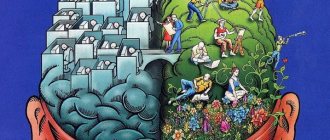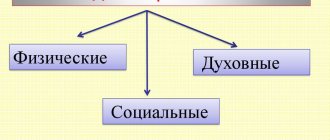First, let's define what a psychological portrait of a person is. A psychological portrait of a personality is a description of the inner world of an individual. Personality type, temperament, character, interests, abilities and much more are considered. Describing the psychological characteristics of a person is a complex process that involves several stages. Each of them has its own nuances and meaning, none of them should be missed. Let's figure out how and why you can create a psychological (socio-psychological) portrait of a personality.
What is it like?
This is a decoding of personality in writing, in words. It makes it possible to recognize the individual facets of a person, identify his abilities, and determine possible actions.
This technique is widely in demand and is used in all areas of activity - personal, professional, scientific. Recruiting agencies analyze the abilities of job applicants, teachers draw up psychological descriptions of students to successfully build a curriculum, managers identify the weaknesses and strengths of employees.
Melancholic
Motto: do no harm!
The psychological portrait marked “melancholic” is as follows: the strengths of the personality are gentleness, the ability to sympathize, humanity, high sensitivity and goodwill. The disadvantages of this type of temperament are suspiciousness, shyness, low performance, isolation, daydreaming and vulnerability. Never shout at a melancholic person, do not put pressure on him, do not give harsh and harsh instructions, as this person is extremely sensitive to intonation and is too vulnerable.
It is very difficult to find an individual who would fully meet a certain temperament; usually one of them is dominant.
What is it for?
Everyone can try to make their own psycho-portrait or study the behavior of a loved one. However, to obtain accurate and most reliable data, it is better to seek help from a specialist. To fully determine your personality characteristics, sign up for my personal consultation. Having such data, you can find the most suitable occupation, hobby, find out the degree of your openness and sociability, identify goals, and increase self-esteem.
Focus
Motivation for activity and behavior, satisfaction of needs - all this underlies the orientation of the individual (on a task, on oneself or on communication).
Some may only be satisfied with security and satisfaction of physiological needs. And for others, in addition to this, it is no less important to satisfy social needs, the need for self-expression, and also to realize their creative abilities. The main task of a manager and psychologist is to identify the needs, beliefs and interests of each individual and determine the direction of his motives.
Key points
The portrait includes a detailed examination of several aspects.
Temperament
Scientifically, 4 groups of people have been identified: phlegmatic, sanguine, choleric and melancholic. Temperaments are practically never found in their perfect form. Typically, a personality combines two different types. Depending on our internal state and emotionality, we manifest ourselves differently in life processes, react to the same situations, participate in conversations and start relationships. It is worth considering that the type of temperament is an innate parameter that does not change during existence. Do not expect that an indifferent phlegmatic person will suddenly become an organizational and explosive choleric person, and even if changes appear to you, most likely this is a temporary impulse and an erroneous judgment. Only a slight adjustment to the original data has been proven.
- Choleric people are the most active, hardy, bright and strive towards their goal.
- Melancholic people, on the contrary, are vulnerable, calm, and indecisive.
- Phlegmatic people communicate easily, they are reliable friends and co-workers who adequately assess any situation.
- Sanguine people are sociable, sincere, sympathetic and friendly.
Character
This is a set of stable behavioral traits that can transform and change over time depending on the environment, upbringing and life shocks. Although it is believed that the initial list of parameters is laid down at the genetic level, it is significantly supplemented by moral principles acquired over time.
Thus, children of the same parents, when brought up in families with different foundations, can turn out to be completely opposite personalities. The character of any person can be simultaneously described from two sides. For example, you can be kind, sincere and open, but at the same time jealous, touchy or lazy.
Capabilities
Literary sources divide them into three groups: spiritual, physical and social. Naturally, the physiological ones are instilled first - health, skills, strength, endurance. Spiritual ones depend more on upbringing and habitat. This is education, cultural inclinations, morals. Social ones are also acquired and formed in the process of life - these are openness, sociability, the ability to establish contacts, responsibility, high punctuality and strong discipline.
Focus
The foundation of this parameter is motivation. It represents a person’s daily activities and explains his actions. Some people want to satisfy their physiological needs, they want to eat delicious food, live in a cozy apartment or drive a modern car. For others, it doesn’t matter, and their priorities include communication, new information, making acquaintances, realizing their creative potential, and playing sports.
Emotionality
This parameter is expressed in the ability and way to express one’s feelings and experiences to others, to show one’s mood or, conversely, to hide it. Depending on the degree of emotionality present in you, you form a different reaction to the surrounding reality. This is what makes it possible to understand your neighbor, regardless of his language, culture, religion or level of intelligence. Everyone will be able to recognize anger, happiness, and fear in their interlocutor.
Psychologist Daria Milai
Make an appointment
Intelligence
A person is able to develop himself through the perception of new information, practical exercises, and the accumulation of experience, but the basic level of intellectual development with which a child is born plays a key role. It helps to adapt to new conditions, evaluate an unfamiliar situation and the behavior of third parties, make assessments and conclusions. This is the ability to think rationally and act correctly regarding the current situation. As a rule, talent or aptitude for any field of knowledge is discovered already in childhood; the main thing is not to miss this moment and begin to develop it.
Communication skills
Any individual, regardless of the number of years lived, financial and social status, level of intellectual development, should be able to form communication with others. However, the ability to speak is not equally developed among individuals. For example, a psychoportrait of a comedian or manager should reveal a high level of communication skills, in contrast to a gardener, combine operator or fisherman. It is worth considering that any professional activity is inseparably linked with communication, and in the absence of this parameter, achieving success and getting a promotion will be almost impossible.
Self-esteem
This is the level of self-confidence. Conventionally, it is divided into overestimated, underestimated and objective. With the first, there is an overestimation of one’s capabilities, a deliberate overestimation of achievements, or even attribution of other people’s heights to oneself. In the second, on the contrary, there is excessive self-criticism and lack of confidence in one’s abilities, while normal speaks about an adequate assessment of oneself and one’s actions. If you have identified low self-esteem, it is better to seek help from a qualified specialist.
Face-to-face consultation
What are the features and advantages of face-to-face consultation?
Find out more
Skype consultation
What are the features and benefits of Skype consultations?
Find out more
Strong-willed qualities
Will is a kind of internal core of personality, strength of character and the main parameter that allows you to achieve success. Strong-willed qualities are purposefulness, firm determination and complete independence, lack of fear of taking risks, and the ability to take responsibility. Even with positive living conditions, high intelligence, and talent, without will an individual will not achieve effective results. A strong-willed person does not have the harmful laziness, lack of initiative, lack of discipline, or weak character.
Self-control
Controlling yourself, your emotions, words and actions, being well-mannered - these are the qualities that will help you establish good communication with others, establish business or love relationships. Those who cannot sufficiently control themselves and keep their mouth shut will not have worthy interlocutors. Many companies pay attention to this skill when hiring employees. Recruiters deliberately create various stressful situations and ask uncomfortable questions to understand how you will behave.
Teamwork ability
Not all individuals have the ability to work in a team. However, it is a valuable skill that allows you to adapt and listen to other people. It needs to be developed from childhood.
Motivation
One of the most powerful qualities of a person. Even a lazy and indecisive individual, if necessary and willing to make a purchase, get a position or win the favor of an interlocutor, can take unexpected and rash actions, accelerating the process of achieving a goal. For different people, motivation can be hidden, superficial or strong, reaching the point of mania and passion.
Social attitudes
One of the consequences of communication is the transfer of information - the exchange of news, experience, information. Data received from outside influences the behavior, mood and actions of people, pushing them to certain actions.
Choleric
Motto: not a moment of peace!
The principle of communicating with a choleric person is based on the use of his advantages: enthusiasm, mobility, energy, passion and determination. At the same time, it neutralizes the disadvantages of this type of temperament: aggressiveness, intolerance, lack of self-control, and conflict. A psychological portrait with the characteristic “choleric” should suggest that a person should always be busy with some kind of activity. Otherwise, he will direct all his energy and activity to the team and can disintegrate it from the inside.
How to draw up the correct psychological portrait of any person: sample
To draw up a psycho-portrait of yourself or someone else, you need to seek help from a specialist in the field of psychology or try to do it yourself. Various questionnaires, effective methods and techniques for assessing a person’s personality and scrupulously analyzing their abilities will help you. These include a portrait based on a drawing, studying handwriting, posing logical riddles, testing, communicating without words, but the easiest and fastest option is studying the properties described above. You just need to take a notepad and write down each item.
Plan
A typical sample will tell you how to make a reliable psychological portrait of a person. You should follow simple instructions:
- Consider personal data - gender, age, external parameters.
- Social status – position, specialty, marital status.
- A short biography, which indicates the main, most important events and moments of life, shocks, emotions.
- Analysis of the 13 personality traits described above.
- Conclusions, in which each item is examined in detail, existing problems are identified, ways to solve them, and abilities and skills are revealed.
You must understand that the technique must correspond to the age, experience and level of education of the person being studied. It is necessary to create comfortable conditions for the experiment. The overall picture must be drawn up in such a way that it is understandable to a person without specialized education and does not burden it with unknown terms.
Compilation example
A psychological portrait, regardless of its purpose, is drawn up by a specialist. The psychologist determines the appropriate methodology in accordance with the purpose of the test. For independent analysis, you can use simplified methods. Socionics and DISC research are suitable, for example. Such tests can be taken online - they are available on the Internet.
What does a finished psychological portrait look like? An example is presented below. His conclusion is based on the results of tests by Eysenck, Mehrabian, and Cattell:
- Elena Nikiforova, student, 20 years old;
- character traits: sociability, friendliness, impulsiveness, good nature, tendency to aggression, actions under the influence of emotions, emotionality;
- temperament (Eysenck test): sanguine, easy to communicate, make friends, good ability to adapt;
- intellectual qualities (Cattell test): quick perception of information, abstract thinking;
- motivation (Mehrabian test): achieving the intended goal;
- emotionality: average stability, irritability, excitability, stubbornness;
- sociable qualities: sociability, independence, activity, desire for leadership, good adaptive abilities;
- conclusions: the results of the study are within normal limits, it is recommended to pay attention to increased suspicion.
After a detailed consideration of what a psychological portrait is, its role in the modern world becomes clear. It is used in many areas of human life: in the professional, social, and personal spheres. The psychological characteristics of an individual are an important factor in choosing a life path and career path.
IMPORTANT! Informational article! Before use, you should consult a specialist.
Example and writing sample: how to create a psychological portrait of a personality
Historical publications, brochures, textbooks, and fiction are filled with a lot of information about the lives of famous people. Of course, their psychoportraits deserve special attention. Everyone wants to know the subtleties of nature and character inclinations of Hitler, Pushkin, Stalin, Joan of Arc and other outstanding people. Characteristics reveal the reasons for their behavior, lifestyle, and the formation of motivation. The analysis was carried out on the basis of personal diaries, written eyewitness accounts, and decrypted archives. Sometimes preserved photos and video fragments are used to detail the data. As an example of how to write a psychological portrait of a personality, I will describe the person of Napoleon Bonaparte:
- This is a short man. He suffered from epilepsy.
- According to the plan, personal information about the subject was compiled: the Emperor of France, an active statesman. Married twice.
- There is a love of literature and military affairs. Uncommunicative, suffered excessively from bullying by peers.
- An active and efficient person, purposeful, punctual, disciplined, but moderately selfish. An excellent strategist who perceives and processes new information with lightning speed and also quickly makes decisions. An antisocial person who is disgusted with others. He kept himself in control, even in the presence of internal turmoil and troubles.
- The main motivation is the thirst for power.
- High position in society, position and social status significantly aggravated the problems that arose in childhood and gave rise to anger and contempt for people.
This is a good example from the psychology of competently drawing up a psychological portrait of a non-standard personality. Having analyzed the commander’s youth and living conditions, his aggression, irritability and rejection of society in the future become clear.
Ask a question
Sanguine
Motto: trust, but verify!
The advantages of this type of temperament are cheerfulness, sociability, enthusiasm and responsiveness, and the disadvantages are scatteredness, over-sociability, frivolity, a tendency to arrogance, superficiality and unreliability. The psychological portrait of a person marked “sanguine” is as follows: the individual is always happy to promise something so as not to offend the applicant, but he does not always keep his word, so you should check whether he fulfilled his promise.











